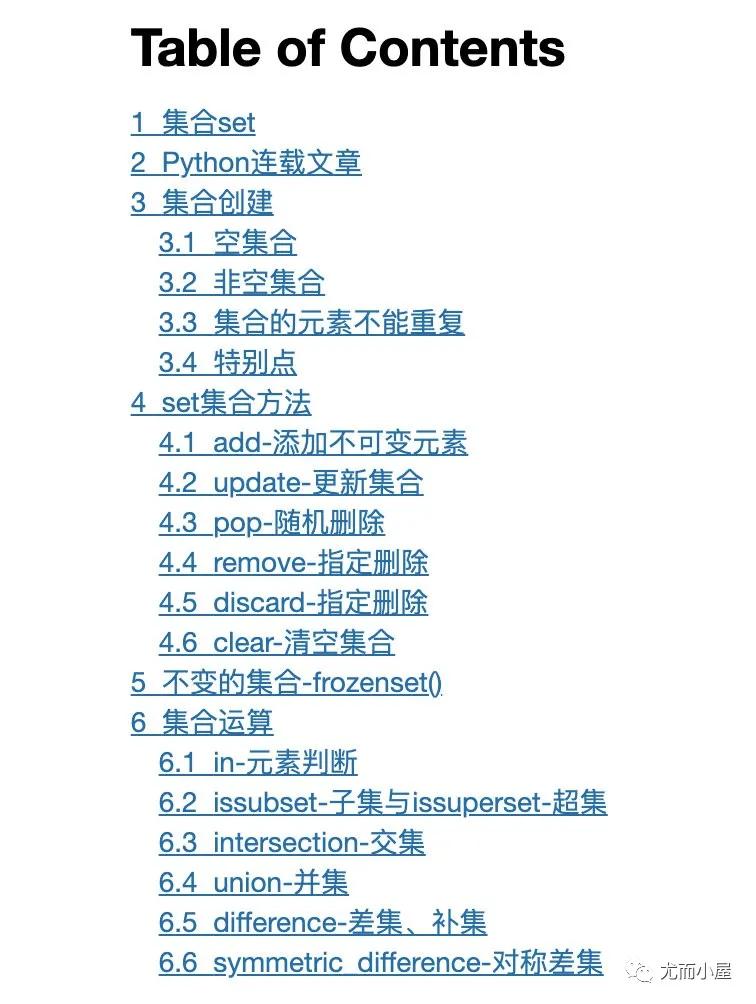本文转载自微信公众号「尤而小屋」,作者尤而小屋。转载本文请联系尤而小屋公众号。
大家好,我是Peter~
在前面的几篇Python的文章中,我们介绍了Python的多种不同类型的对象:字符串、列表、元组、字典。它们有各自的特点:
- 字符串str:存在索引,字符串中的元素是可以重复的,元素是不可变,不能修改的
- 列表list:也能够进行索引和切片操作,元素可以修改,是可变的
- 元组tuple:可以看成是不能进行修改的“列表”;元素不能直接修改,也可以进行索引和切片操作,类似列表
- 字典:Python中十分常用,键值对组成,键必须是比可变的数据类型(比如元组),值可以是任意数据;字典是无序的
如果说元组是列表和字符串的杂合体,那么集合可以看做是列表和字典的杂合体
Python连载文章
本文的整体目录结构:
集合创建
集合set的创建有两种方法:
通过set函数创建,空集合只能用这种方式
通过{}来创建
空集合
s1 = set() # 空集合
s1
- 1.
- 2.
set()
type(s1)
- 1.
set
注意:空集合必须使用set函数来创建,因为{}是用来创建空字典的
非空集合
使用花括号创建
s2 = {1,2,3,4}
s2
- 1.
- 2.
{1, 2, 3, 4}
type(s2)
- 1.
set
使用set函数创建
s3 = set([9,8,7,6]) # 将元素用列表装起来,set只能有一个参数
s3
- 1.
- 2.
{6, 7, 8, 9}
type(s3)
- 1.
set
s4 = set((11,22,33,44)) # 用元组装起来
s4
- 1.
- 2.
- 3.
{11, 22, 33, 44}
集合的元素不能重复
集合中的元素是不能重复的;如果有重复的元素,集合会自动去重。这是一种非常高效的去重方式
s5 = set([1, 2, 3, 4, 3, 2, 1]) # 存在重复数据
s5
- 1.
- 2.
- 3.
{1, 2, 3, 4}
产生的数据中自动将重复的去掉了
type(s5) # 查看类型
- 1.
set
s6 = set("javascript") # 字符串中a重复了,自动去重
s6
- 1.
- 2.
{'a', 'c', 'i', 'j', 'p', 'r', 's', 't', 'v'}
特别点
当我们创建集合的时候,需要注意数据类型
s7 = {"python", [1,2,3,"java"], {"name":"xiaoming","age":19},100}
s7
- 1.
- 2.
- 3.
TypeError Traceback (most recent call last)
<ipython-input-11-b8ed1637ec12> in <module>
----> 1 s7 = {"python", [1,2,3,"java"], {"name":"xiaoming","age":19},100}
2 s7
TypeError: unhashable type: 'list'
- 1.
- 2.
- 3.
- 4.
- 5.
- 6.
- 7.
- 8.
上面报错中的关键词:unhashable,中文是不可哈希的。意思是创建的时候存在不可哈希的数据类型:列表 。我们可以记住:
- 不可哈希,即代表可变,比如列表、字典等
- 可哈希,即代表不可变,比如字符串,字典的键等
当我们创建集合的时候,元素必须是可哈希的
set集合方法
首先我们通过dir(set)来查看集合的操作方法:
print(dir(set))
- 1.
['__and__', '__class__', '__contains__', '__delattr__', '__dir__', '__doc__', '__eq__', '__format__', '__ge__', '__getattribute__', '__gt__', '__hash__', '__iand__', '__init__', '__init_subclass__', '__ior__', '__isub__', '__iter__', '__ixor__', '__le__', '__len__', '__lt__', '__ne__', '__new__', '__or__', '__rand__', '__reduce__', '__reduce_ex__', '__repr__', '__ror__', '__rsub__', '__rxor__', '__setattr__', '__sizeof__', '__str__', '__sub__', '__subclasshook__', '__xor__', 'add', 'clear', 'copy', 'difference', 'difference_update', 'discard', 'intersection', 'intersection_update', 'isdisjoint', 'issubset', 'issuperset', 'pop', 'remove', 'symmetric_difference', 'symmetric_difference_update', 'union', 'update']
add-添加不可变元素
集合中添加元素
s3 # 原集合
- 1.
{6, 7, 8, 9}
s3.add(1) # 添加1
- 1.
s3
- 1.
{1, 6, 7, 8, 9}
s3.add(2) # 添加2
- 1.
s3
- 1.
{1, 2, 6, 7, 8, 9}
s3.add([1,3,5])
- 1.
---------------------------------------------------------------------------
TypeError Traceback (most recent call last)
in
----> 1 s3.add([1,3,5])
TypeError: unhashable type: 'list'
- 1.
- 2.
- 3.
- 4.
- 5.
- 6.
- 7.
报错提示:列表是不可哈希,也就是可变类型的。之前我们说过:集合中的元素都是可哈希(不可变类型),所以不能直接添加
list1 = [1,3,5]
tuple1 = tuple(list1) # 列表转成元组,元组是不可变的
tuple1
- 1.
- 2.
- 3.
- 4.
- 5.
(1, 3, 5)
s3.add(tuple1) # 添加元组
- 1.
s3
- 1.
{(1, 3, 5), 1, 2, 6, 7, 8, 9}
update-更新集合
更新集合中的元素,将两个集合中的元素组合在一起
# 创建两个集合,有相同的元素“python”
s8 = set(["python","java","c"])
s9 = set(["python","go","javascript","html"])
- 1.
- 2.
- 3.
- 4.
s8.update(s9)
- 1.
s8
- 1.
{'c', 'go', 'html', 'java', 'javascript', 'python'}
生成的数据中自动将python去重了
s9 # s9还是没有变化的
- 1.
{'go', 'html', 'javascript', 'python'}
update的参数不仅仅是集合,它的参数是不可变数据类型:
help(set.update) # 查看方法的文档信息
- 1.
Help on method_descriptor:
update(...)
Update a set with the union of itself and others.
s9.update("hello")
- 1.
s9
- 1.
{'e', 'go', 'h', 'html', 'javascript', 'l', 'o', 'python'}
s9.update((7,8,9))
- 1.
s9
- 1.
{7, 8, 9, 'e', 'go', 'h', 'html', 'javascript', 'l', 'o', 'python'}
pop-随机删除
随机删除一个元素,并且返回删除的结果。pop不能指定参数,也就是不能指定想要删除的元素
s9.pop()
- 1.
'python'
s9.pop()
- 1.
'html'
s9.pop("python") # 不能带参数
- 1.
---------------------------------------------------------------------------
TypeError Traceback (most recent call last)
----> 1 s9.pop("python") # 不能带参数
TypeError: pop() takes no arguments (1 given)
remove-指定删除
删除的元素必须在集合中。如果不存在,则会报错
s8
- 1.
{'c', 'go', 'html', 'java', 'javascript', 'python'}
s8.remove("go")
- 1.
s8 # 结果显示go被删除了
- 1.
{'c', 'html', 'java', 'javascript', 'python'}
s8.remove("go") # 再次删除go就会报错,因为go已经不存在了
- 1.
---------------------------------------------------------------------------
KeyError Traceback (most recent call last)
----> 1 s8.remove("go") # 再次删除go就会报错,因为go已经不存在了
KeyError: 'go'
discard-指定删除
指定删除某个元素,如果元素不存在,也不会报错。
s8 # 原数据
- 1.
{'c', 'html', 'java', 'javascript', 'python'}
s8.discard("html")
- 1.
s8 # 删除后的数据
- 1.
{'c', 'java', 'javascript', 'python'}
s8
- 1.
{'c', 'java', 'javascript', 'python'}
s8.discard("go")
- 1.
上面的结果表明:如果删除的元素不存在,也不会报错。这个是和remove不一样的地方
clear-清空集合
删除集合中的全部元素
s8
- 1.
{'c', 'java', 'javascript', 'python'}
s8.clear() # 清空了集合
- 1.
s8
- 1.
set()
bool(s8) # bool值为False
- 1.
False
不变的集合-frozenset()
上面通过set方法创建的集合,我们了解到:集合是可变的,也就是可修改的,或者说不可哈希的。
实际上还有一种方式创建的集合是不可变的:frozenset(),可以理解成冻集合,所以就不能进行修改等操作啦。
f_set = frozenset("python")
f_set
- 1.
- 2.
- 3.
frozenset({'h', 'n', 'o', 'p', 't', 'y'})
我们查看下这个冻集合的操作方法
print(dir(f_set)) # 冻集合
- 1.
['__and__', '__class__', '__contains__', '__delattr__', '__dir__', '__doc__', '__eq__', '__format__', '__ge__', '__getattribute__', '__gt__', '__hash__', '__init__', '__init_subclass__', '__iter__', '__le__', '__len__', '__lt__', '__ne__', '__new__', '__or__', '__rand__', '__reduce__', '__reduce_ex__', '__repr__', '__ror__', '__rsub__', '__rxor__', '__setattr__', '__sizeof__', '__str__', '__sub__', '__subclasshook__', '__xor__', 'copy', 'difference', 'intersection', 'isdisjoint', 'issubset', 'issuperset', 'symmetric_difference', 'union']
print(dir(s9)) # set集合,非冻集合
- 1.
['__and__', '__class__', '__contains__', '__delattr__', '__dir__', '__doc__', '__eq__', '__format__', '__ge__', '__getattribute__', '__gt__', '__hash__', '__iand__', '__init__', '__init_subclass__', '__ior__', '__isub__', '__iter__', '__ixor__', '__le__', '__len__', '__lt__', '__ne__', '__new__', '__or__', '__rand__', '__reduce__', '__reduce_ex__', '__repr__', '__ror__', '__rsub__', '__rxor__', '__setattr__', '__sizeof__', '__str__', '__sub__', '__subclasshook__', '__xor__', 'add', 'clear', 'copy', 'difference', 'difference_update', 'discard', 'intersection', 'intersection_update', 'isdisjoint', 'issubset', 'issuperset', 'pop', 'remove', 'symmetric_difference', 'symmetric_difference_update', 'union', 'update']
通过对比两种集合的操作方法,我们发现:冻集合中明显是少了很多增加、删除等方法,所以冻集合是不可变的
集合运算
在这个小节中介绍的是集合中的各种运算,比如:交集、并集、补集等
in-元素判断
s5
- 1.
{1, 2, 3, 4}
1 in s5
- 1.
True
6 in s5
- 1.
False
issubset-子集与issuperset-超集
A如果是B的子集,那么B就是A的超集;也就说A的元素全部在B中
s10 = {1,2} # 创建一个新的集合
s10
- 1.
- 2.
{1, 2}
s10.issubset(s5) # s10是s5的子集
- 1.
True
s5.issuperset(s10) # s5是s10的超集
- 1.
True
s9
- 1.
{7, 8, 9, 'e', 'go', 'h', 'javascript', 'l', 'o'}
s9.issubset(s5) # 很显然s9不是s5的子集
- 1.
False
intersection-交集
求两个集合的交集,使用intersection函数或者&
print(s5)
print(s10)
- 1.
- 2.
- 3.
{1, 2, 3, 4}
{1, 2}
s5.intersection(s10)
- 1.
{1, 2}
s5 & s10
- 1.
{1, 2}
union-并集
使用函数union或者|来表示两个集合的并集,会生成一个新的对象
print(s5)
print(s9)
- 1.
- 2.
- 3.
{1, 2, 3, 4}
{'javascript', 'o', 7, 'l', 'go', 'h', 8, 9, 'e'}
s11 = s5|s9
s11
- 1.
- 2.
{1, 2, 3, 4, 7, 8, 9, 'e', 'go', 'h', 'javascript', 'l', 'o'}
s5.union(s9)
- 1.
{1, 2, 3, 4, 7, 8, 9, 'e', 'go', 'h', 'javascript', 'l', 'o'}
difference-差集、补集
使用函数difference或者减号-
print(s5)
print(s10)
- 1.
- 2.
- 3.
{1, 2, 3, 4}
{1, 2}
s5 - s10
- 1.
{3, 4}
s5.difference(s10)
- 1.
{3, 4}
s10 - s5
- 1.
set()
symmetric_difference-对称差集
使用函数symmetric_difference或者symmetric_difference_update(原地更新数据)
s12 = {1,3,4,5,7}
s12
- 1.
- 2.
- 3.
{1, 3, 4, 5, 7}
s5 # 原数据
- 1.
{1, 2, 3, 4}
s5.symmetric_difference(s12)
- 1.
{2, 5, 7}
s5 # 原数据没有改变
- 1.
{1, 2, 3, 4}
s5.symmetric_difference_update(s12)
- 1.
s5 # 原数据为输出结果
- 1.
{2, 5, 7}


































